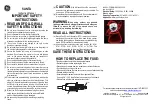
2. Very rarely tilt occurs directly in the camera; if the camera has not been hit
hard, for example, has not fallen from a height. The sensor is permanently
welded to the circuit board and this is tightened to the solid housing with
screws.
3. With some optics (e.g., Celestron RASA fast telescopes), the apparent eff ect to
tilt can be caused by misalignment of the backfocus. In the center, stars will be
in focus, but because the sensor is at the wrong distance from the telescope,
the image cannot be focused across the entire plane. A characteristic feature
of this type of problem is that the elongated shape of the stars is the same in
each corner - the problem is symmetrical with respect to the optical axis.
4. Finally, tilt can be due to technical problems of the telescope. This is a very
common cause with refl ectors (telescopes with mirrors). Mirrors are heavy
and their surface is optically very sensitive. Any stress created in the telescope,
when transferred to the mirror, can cause astigmatism, giving a similar eff ect to
sensor tilt. The problem is that there are several moving or potentially moving
parts in refl ectors - the focusing mechanism, the collimation mechanism, any
mounting screws, the housing which is subject to defl ection under the action
of force moments, on top of that a heavy mirror wanting to fl op. This kind of
problem is hard to eliminate. Sometimes mirror lock helps, if the telescope
has such a mechanism. Sometimes it helps to remove the electric focuser and
relax tensions that has developed on the focus rod. While collimation can be
corrected, astigmatism most likely requires service at a specialized workshop.
Unfortunately, astigmatism is quite hard to determine without performing
professional tests. Sometimes, however, it is pronounced enough to observe
a characteristic feature: star shapes are elongated not only in the corners,
but also in the center, where the star is in focus. Of course, it is necessary to
rule out problems with mount tracking or guiding beforehand. However, if the
elongation in the center is of the same length independent of the exposure
time, and if the star fl ares are also asymmetrically elongated in the same
direction - you are most likely just dealing with astigmatism. In this case,
tilt is a secondary phenomenon, and its correction alone may not be able to
suffi
ciently improve image quality. In other words, no change in the tilt of the
sensor will fully remove the eff ects of astigmatism. An extreme case would
be when mirror fl op, or some other phenomenon, progresses during a photo
shoot. At fi rst you observe a small distortion, but after a few hours it is very
large. In another situation, the image may dramatically change in quality after
a meridian fl ip, or after pointing the telescope to a diff erent altitude above
- 27 -
Содержание TC 900
Страница 1: ...Tilt Corrector TC 900 User Manual rev 2022 11 09 ASTRODEVICE...
Страница 6: ...g 1 X X X X X 7 X R1 R2 S1 S2 S3 T1 T2 T3 B1 B2 B3 H1 H2 H3 H4 BS1 BS2 BS3 TS TS TS TS TS TS...
Страница 8: ...g 2 g 3 g 4 9...
Страница 10: ...11 g 5 g 6 g 7 11...
Страница 11: ...g 8 g 9 12...
Страница 13: ...g 10 g 11 14...
Страница 14: ...g 12 g 13 15...
Страница 15: ...g 14 g 15 3 mm 16...
Страница 17: ...g 16 g 17 18...
Страница 18: ...g 18 d m ax 70 m m h 5 m m g 19 19...
Страница 20: ...g 20 g 21 21...
Страница 21: ...g 22 g 23 22...
Страница 22: ...g 24 g 25 23...
Страница 30: ...g 30 S1 S2 S3 31...
Страница 33: ...g 31 g 32 34...
Страница 35: ...g 33 g 34 36 when you made the corrections with the Tilt Corrector...
Страница 36: ...g 35 1 2 3 4 5 6 g 36 37...
Страница 37: ...g 37 g 38 38...
Страница 39: ...g 39 g 40 40...
Страница 42: ...Copyright 2022 All Right Reserved Astrodevice is a registered trademark www astrodevice com...
















































